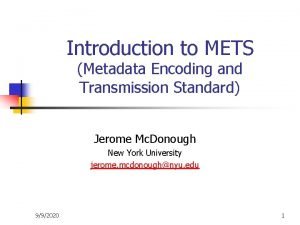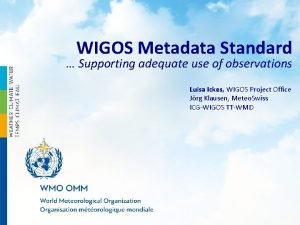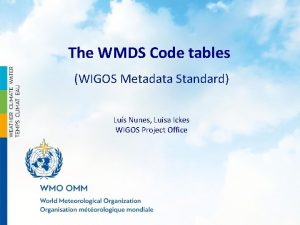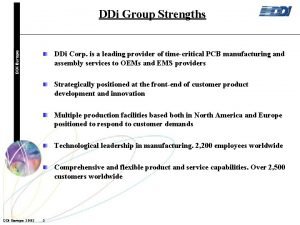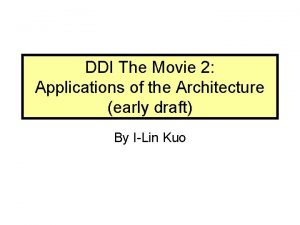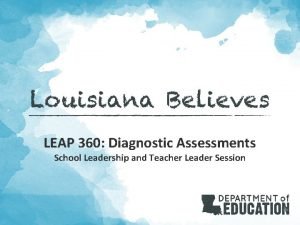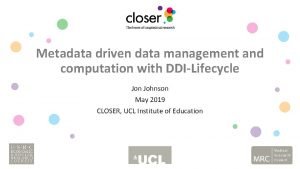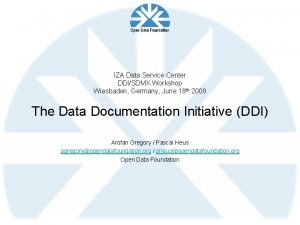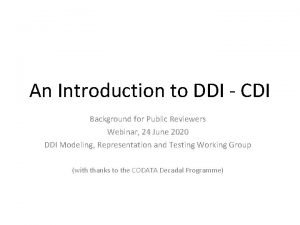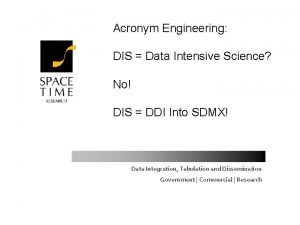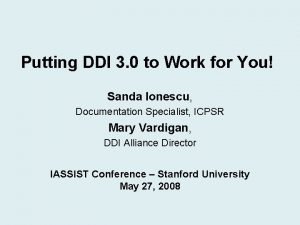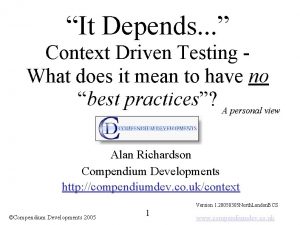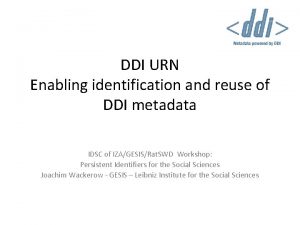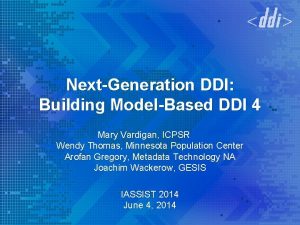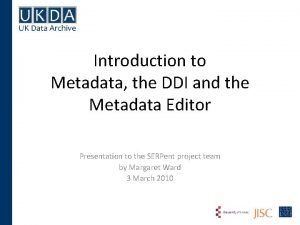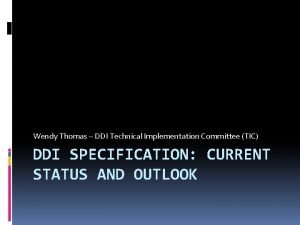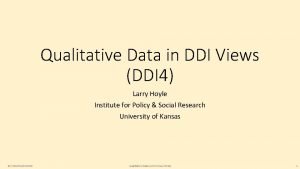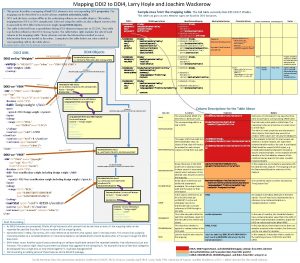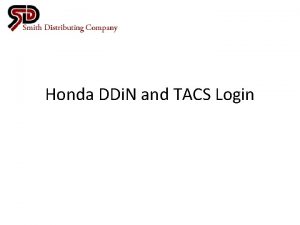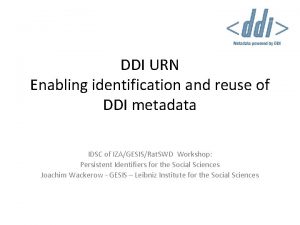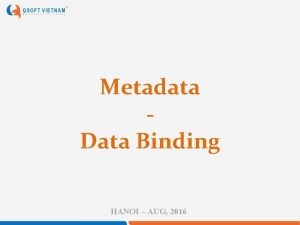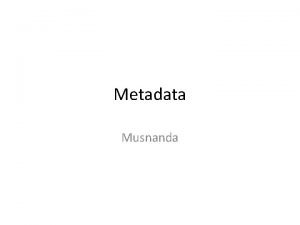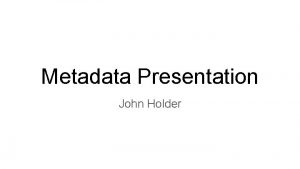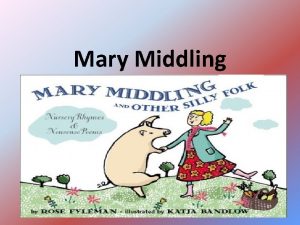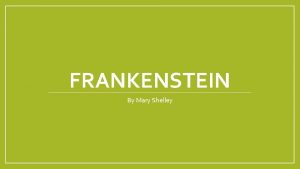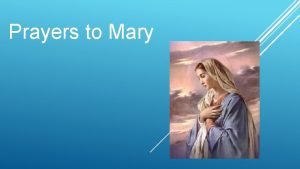DDI A Metadata Standard for the Community Mary


























- Slides: 26

DDI - A Metadata Standard for the Community Mary Vardigan ICPSR – Inter-university Consortium for Political and Social Research Joachim Wackerow GESIS – Leibniz Institute for the Social Sciences 1 st North American DDI User Conference April 2 -3, 2013 – Lawrence, Kansas

Today’s Presentation -- “State of the DDI“ • • What is DDI? Benefits and Principles Barriers and Challenges DDI of the Future How You Can Help

What is DDI? Application using parts of DDI Reality Survey/ Register Documentation Structured Metadata in DDI

A Project of and for the Community • Developed by a self-sustaining membership Alliance recently reconfigured with new Bylaws • Two major development lines – DDI Codebook – DDI Lifecycle • Metadata for both human and machine consumption • Additional specifications: – Controlled vocabularies – RDF vocabularies for use with Linked Data

Primary Benefits Rich content (currently over 800 items) Metadata reuse across the life cycle Machine-actionability Data management and curation Support for longitudinal data and comparison Support for preservation and platform-independent software • Support for a global network • • •

Metadata Reuse

Machine-Actionability

Longitudinal Data and Comparison Ingo Barkow, William Block, Jay Greenfield, Arofan Gregory, Marcel Hebing, Larry Hoyle, Wolfgang Zenk-Möltgen. “Generic Longitudinal Business Process Model. ” http: //dx. doi. org/10. 3886/DDILongitudinal 05

Paradigm Shift • Using structured metadata in standardized form -- a paradigm shift for social science research infrastructure • We might compare this to the change in the 1990 s when people began to understand the value of linked documents

Distributed Approach • Shift from centralized maintenance and control of metadata by the researcher or archive to a distributed approach • More efficient and easier to capture information about an event at the time of its occurrence rather than after the fact

Barriers and Challenges • • • Complexity Level of researcher buy-in Need for tools Changes in workflow Access to metadata

Measuring Success • Adoption around the world – Projects range from the General Social Survey in the U. S. , to the Research Data Centres in Canada, to Statistics New Zealand – Through IHSN, DDI is now being used in over 70 countries – DDI is a centerpiece of proposed CESSDA-ERIC (European Research Infrastructure Consortium)

Global DDI

Moving Forward: RDF Vocabularies for Semantic Web • DDI-RDF Discovery Vocabulary For publishing metadata about datasets into the Web of Linked Data Based on DDI Codebook and DDI Lifecycle • XKOS RDF vocabulary for describing statistical classifications, which is an extension of the popular SKOS vocabulary Publication expected in second half of 2013

RDF Discovery Vocabulary

DDI of the Future • Robust and persistent data model (for the metadata), with extension possibilities, variety of technical expressions • Complete data life cycle coverage • Broadened focus for new research domains • Simpler specification that is easier to understand use including better documentation

Why Now? • Experiences in developing and using the initial DDI Lifecycle structure • Lack of a data model proved limiting in: • Further improvement of the development line 3. * • Development of sustainable software based on different versions of DDI • Pressure for changes from several directions at once • New content from substantive working groups • Being approached by new communities

Specific Changes Envisioned I • Abstraction of data capture/collection/source to handle different types of data • New content on sampling, survey implementation, weighting, and paradata • New content developed by the Qualitative Working Group • Framework for data and metadata quality • Framework for access to data and metadata

Specific Changes Envisioned II • Process (work flow) description across the data life cycle, including support for automation and replication • Integration with GSBPM/GSIM, SDMX, CDISC, Triple-S • Disclosure review and remediation • Data management planning • Development of standard queries and/or interface specifications (such as REST), needed to enable interoperable services

High-level Design Goals I Coming out of Dagstuhl 2012 workshop: 1. 2. 3. 4. 5. 6. 7. Interoperability and Standards Simplicity User Driven Terminology Iterative Documentation Lifecycle Orientation

High-level Design Goals II 8. Reuse and Exchange 9. Modularity 10. Stability 11. Extensibility 12. Tool Independence 13. Innovation 14. Actionable Metadata

DDI in Relation to GSIM and Other Standards DDI

Alignment with GSIM

DDI Development Lines • DDI Codebook – DDI 2. 1 (DTD) – DDI 2. 5 (XML Schema) • DDI Lifecycle – DDI 3. 1, 3. 2 (XML Schema) – DDI X (model-based) • Bindings as – XML Schema – RDF • Data as a Service, Service Oriented Architecture (SOA), Web services, REST • Recommendations for schemas for database management systems

Time Line Moving Forward • New work initiated at Dagstuhl workshops on “Moving Forward” in Autumn 2012 • Planned to continue in October 2013 • Ongoing virtual work involving the community in progress – roadmap developed yesterday • User stories and core being defined • Mapping among DDI, SDMX, GSIM under way • First draft of model expected by end of 2014

You Can Contribute! • Please join us on a working group • Participate in technical work, including modeling • Join the DDI Alliance!
 Mets metadata
Mets metadata Wigos metadata standard
Wigos metadata standard Wigos metadata standard
Wigos metadata standard Ddi heat exchangers
Ddi heat exchangers Ddi pcb
Ddi pcb Movie ddi.to
Movie ddi.to Leap 360 interim assessment answer key
Leap 360 interim assessment answer key Ddi assessments
Ddi assessments Cupom cambial formula
Cupom cambial formula Api driven ddi
Api driven ddi Ddi
Ddi Ddi-cdi
Ddi-cdi Ddi acronym
Ddi acronym Ddi 3
Ddi 3 Ddi compendium
Ddi compendium Ddi heat exchangers inc
Ddi heat exchangers inc Ddi early identifier
Ddi early identifier Mary wollstonecraft mary a fiction
Mary wollstonecraft mary a fiction Fspos
Fspos Typiska novell drag
Typiska novell drag Tack för att ni lyssnade bild
Tack för att ni lyssnade bild Returpilarna
Returpilarna Varför kallas perioden 1918-1939 för mellankrigstiden
Varför kallas perioden 1918-1939 för mellankrigstiden En lathund för arbete med kontinuitetshantering
En lathund för arbete med kontinuitetshantering Underlag för särskild löneskatt på pensionskostnader
Underlag för särskild löneskatt på pensionskostnader Tidbok yrkesförare
Tidbok yrkesförare Sura för anatom
Sura för anatom
